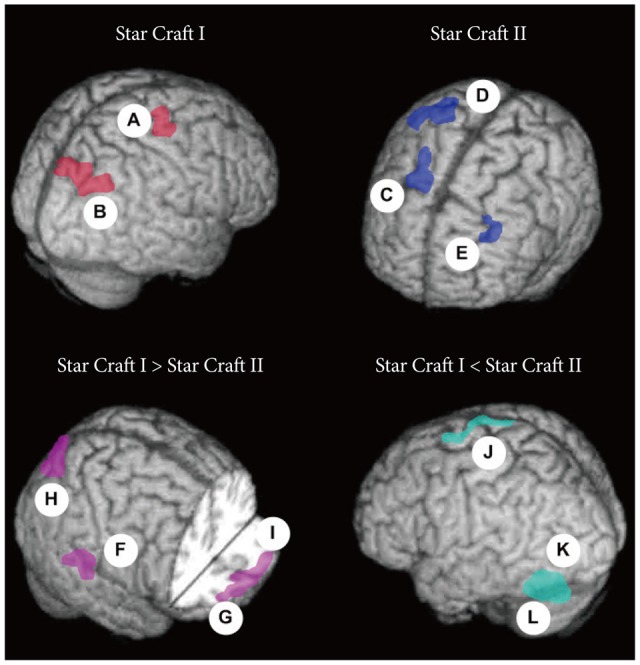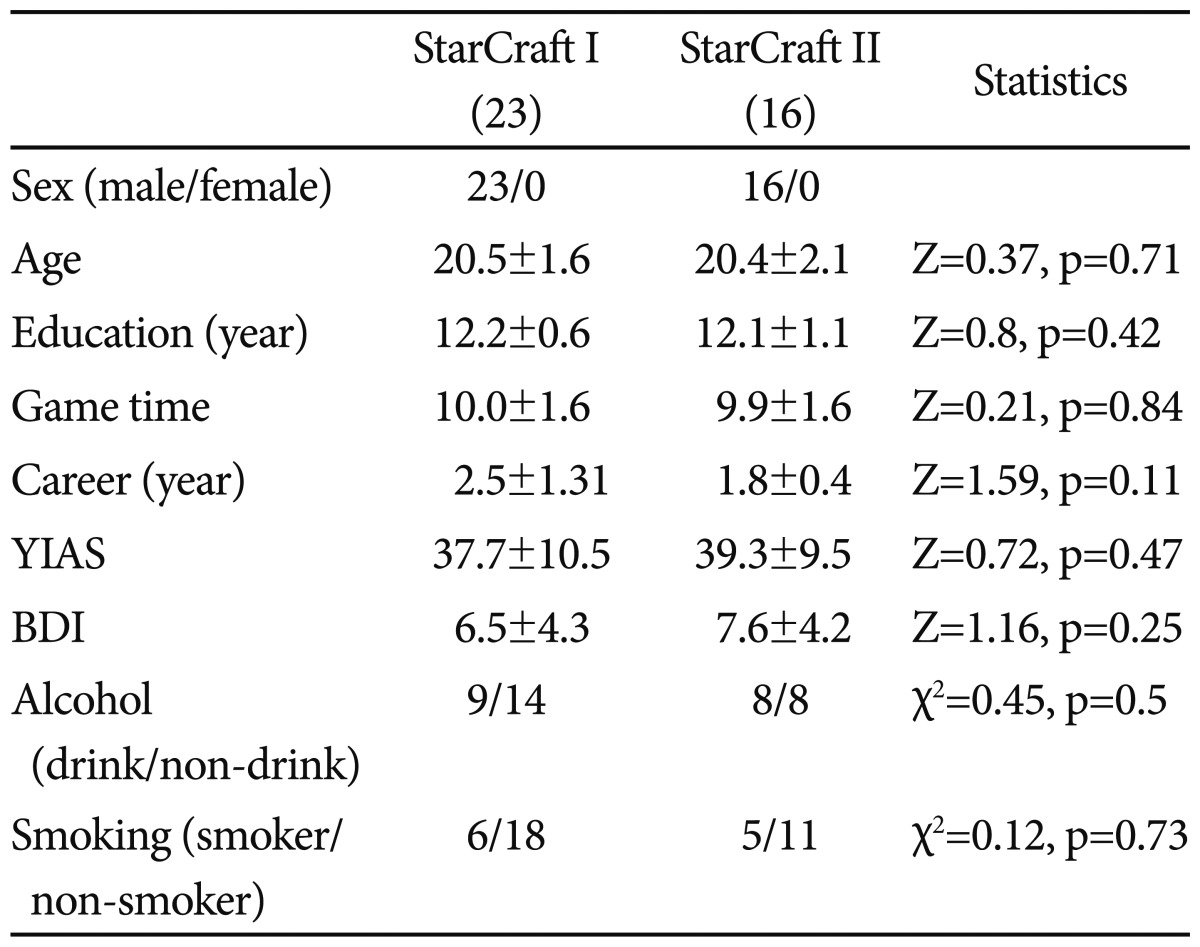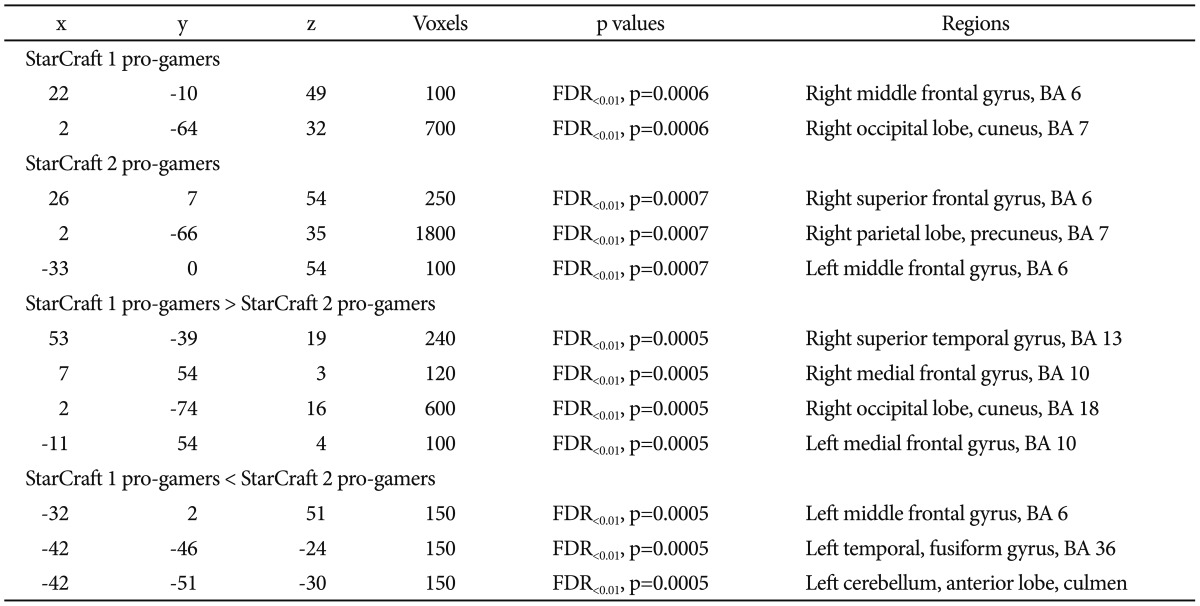Comparison of Brain Activation in Response to Two Dimensional and Three Dimensional On-Line Games
Article information
Abstract
Objective
The present study assessed the difference in the brain activity of professional gamers (excessive players, but not addicts) in response to playing a 3-dimensional online game with an improved interface.
Methods
Twenty-three StarCraft I pro gamers and 16 StarCraft II pro gamers were recruited at Chung Ang University Medical Center. Brain activity in response to StarCraft I or II cues was assessed with a 1.5 Tesla Espree MRI scanner.
Results
StarCraft I pro gamers showed significantly greater activity in 4 clusters in response to the video game cues compared to StarCraft II pro gamers: right superior frontal gyrus, right medial frontal gyrus, right occipital lobe, and left medial frontal gyrus. StarCraft II pro gamers showed significantly greater activity in 3 clusters in response to the video game cues compared to StarCraft I pro gamers: left middle frontal gyrus, left temporal fusiform gyrus and left cerebellum.
Discussion
This is the first study to show the difference in brain activity between gamers playing either a 2-dimensional or 3-dimensional online game. Current brain imaging studies may confirm the pro gamers' experience when playing StarCraft II, a 3-dimensional game with an improved interface, relative to playing StarCraft I.
INTRODUCTION
StarCraft I vs. StarCraft II
StarCraft is one of the bestselling real-time strategy online games. More than 11 million copies of StarCraft I have been sold worldwide since 1998. StartCraft II: Wings of Liberty was released in 2010. Three different races, the Zerg, the Protoss, and the Terrans, perform differently using various tactics with the purpose of allowing a player to defeat their opponent.1 StarCraft I and StarCraft II share basic formats of game play while using the same characters. However, there are 2 main differences between StarCraft I and StarCraft II.2,3 First, StarCraft II is a 3-dimensional game, while StarCraft I is a 2-dimensional game. Second, StarCraft II is somewhat easier for players to control due to improvements in the interface over StarCraft I.2
In South Korea, professional gamers (pro gamers) are players who are characterized by extensive online game playing, but who do not meet the criteria for game addiction. These players are not more impulsive or depressed compared with general users.4 Like other professional sports players, pro gamers have contracts or an annual salary and belong to teams. They maintain a regular lifestyle and are dedicated to their profession despite challenging competition. To become a pro gamer, candidates must complete a two-step competition: they must win a competition including 300 volunteers and a competition involving 8 to 10 semi-pro gamers.5 There are currently approximately 200 StarCraft I pro gamers on 8 StarCraft I teams and approximately 100 StarCraft II pro gamers on 9 StarCraft II teams in Korea.5
2 dimensions (2D) vs. 3 dimensions (3D)
One of the important visual functions is to assess the 3-dimensional shape of objects in response to first encountering that object.6 Studies of 3D perception have suggested that this perception may be systemically distorted.7,8 For example, a straight line in the environment can be perceived as a curved line, and apparent intervals in depth become systemically compressed with increased viewing distance. In addition, stu-dies of the perceptual representation of 3D shapes have suggested that many factors and cognitive interpretations, including depth and orientation, object surface, occlusion contour, surface color, and line-drawings of a simple plane-faced polyhedra can affect 3D perception.9,10 Recent studies have attempted to assess brain activity in response to various factors affecting perception.11,12 In the assessment of event-related potential in response to the surface difference between typical and atypical color objects, the N350 time window was found in 26 healthy subjects.11 The result indicates that surface color is an important cue in the facilitation of long-term memory in 3D perception. In a fMRI study of 3D perception, activity in the bilateral parieto-temporal junction and dorsal portion of the right precuneus was shown to increase in response to increased movement of a 3D ball induced by a cast shadow.12
Game play and interface
Recent studies have suggested that video game training co-uld alter cognitive function and brain activity.13,14 Hubert-Wallander et al.14 demonstrated that action video games could enhance selective attention and the spatial distribution of vision. Lee et al.13 reported that 30th video game (Fortress®) training could alter cognitive functions, including visuospatial attention, goal-directed motor planning, and activity of the right dorsolateral prefrontal cortex, in healthy subjects.
Computer video games are thought of as goal-driven interactive entertainment which includes challenges and conflicts which results in pleasure and intellectually engaging simulation. 15,16 In the human brain, the anterior cingulate and dorsolateral prefrontal corticies are well-known to be associated with conflict control.17
There are significant improvements in terms of interface in StarCraft II, compared to StarCraft I.18 First, the movements of worker 'AI' in StarCraft II are conducted automatically to increase the effectiveness of gathering the mineral while the movements of worker 'SCV' in StarCraft I should manually be controlled by gamers. In addition, StarCraft II needs more multi-tasking abilities to make the strategy with improved rally system, multi-selecting buildings, and pin-point mouse control. For this reason, Many pro gamers reported that StarCraft I needed more multi-tasking functions and finger movements to improve the interface relative to StarCraft II.2
Hypothesis
The goal of the present study was to assess differences in brain activity in response to playing a 3D online game with an improved interface in pro gamers who were not addicts, but only excessive players. The authors hypothesized that the activity of prefrontal cortex and temporal cortex would be different different between the pro gamers playing StarCraft I (2D) and StarCraft II (3D).
METHODS
Subjects
Twenty-three StarCraft I pro gamers and 16 StarCraft II pro gamers were recruited at Chung Ang University Medical Center. All subjects were screened using the Structured Clinical Interview for DSM-IV and the Beck Depression Inventory (BDI).19 Exclusion criteria for both groups were: 1) BDI scores >19; 2) other axis I psychiatric disorders including substance abuse; 3) head injury or trauma history; or 4) impaired behaviors or distress due to maladaptive patterns of online game playing. The research protocol was approved by the Chung Ang University Hospital Institutional Review Board. Written informed consent was provided by all participants. All gamers were male. There were no significant differences in age (z=0.37, p=0.71), years of education (z=0.8, p=0.42), time spent playing games (z=0.21, p=0.84), professional gaming career length (z=1.59, p=0.11), Young's Internet Addiction Scale (YIAS)(z=0.72, p=0.47), BDI scores (z=1.16, p=0.25), alcohol consumption (χ2=0.45, p=0.5) or smoking (χ2=0.12, p=0.73) between StarCraft I and StarCraft II pro gamers (Table 1).
The age of the StarCraft I pro gamers was 20.5±1.6 years, their education year was 12.2±0.6 years, and their career length was 2.5±1.31 years. StarCraft I pro gamers played StarCraft I an average of 10.0±1.6 hours/day. The mean YIAS score of StarCraft I pro gamers was 37.7±10.5 and their mean BDI score was 6.5±4.3. The age of the StarCraft II pro gamers was 20.4±2.1 years, their education level was 12.1±1.1 years, and their career length was 1.8±0.4 years. StarCraft II pro gamers played StarCraft II an average of 9.9±1.6 hours/day. The mean YIAS score of StarCraft II pro gamers was 39.3±9.5 and their mean BDI score was 7.6±4.2.
Study procedure
Assessment of brain activity and craving for game play
All MR imaging was performed on a 1.5-Tesla Espree MRI scanner (SIEMENS, Erlangen, Germany). The subjects were shown a 450-second silent recording consisting of five continuous 90-second segments. Each 90-second segment consisted of three 30-second sub-segments. The 90-second segments consisted of a white cross on a black background (B), a neutral control (N, humanoid robot animation scenes), and the video game cue (C, "StarCraft I" or "StarCraft II" scene). The 5 segments were ordered as follows: B-N-C, B-C-N, C-B-N, N-B-C, and C-N-B. The video was presented using an IFIS-SA™ system (MRI Device Corporation, Waukesha, WI, USA) over a single fMRI scanning session. The fMRI session was recorded using a gradient-recalled echo planar imaging (EPI) sequence [37 transverse slices, 5.0 mm thickness, a voxel size of 3.5×3.5×5.0 mm, TE=30 ms, TR=3000 ms, in-plane resolution=64×64 pixels, field of view (FOV)=230×230 mm] at 3-second intervals. For anatomical imaging, 3D T1-weighted magnetization-prepared rapid gradient echo (MPRAGE) data were collected with the following parameters: TR=1500 ms, TE=3.00 ms, FOV=256×256 mm, 128 slices, 1.0×1.0×1.33 mm voxel size.
fMRI data analysis
Brain activity in current research was analyzed using the Brain Voyager software package (BVQX 1.9, Brain Innovation, Maastricht, Netherlands). The fMRI time series for each subject was co-registered to the anatomical 3-dimensional data set using the multi-scale algorithm provided by BVQX. The structural images were spatially normalized to standard Talairach space. The same nonlinear transformation was applied to the T2*-weighted fMRI time series data. After slice scan time correction and 3D motion correction, the functional data were spatially smoothed using Gaussian kernel with an FWHM of 6 mm and temporally smoothed using a Gaussian kernel of 4 s using algorithms provided by BVQX.
Statistical analysis
The model functions were used as explanatory variables within the context of the general linear model (GLM) to apply multiple linear regression analysis to fMRI signal time-courses on a voxel-by-voxel basis. A random effects analysis yielded individual and group statistical parametric maps of brain activation contrasting the video game cue vs. neutral stimuli. For all analyses, associations were regarded as significant if the False Discovery Rate (FDR) was less than or equal to 0.01 (corrected for multiple comparisons) in 100 adjacent voxels. A second-level analysis of random effects ANOVA model with two within-subject factors (video game cue vs. neutral stimuli) and two between-subject factors (StarCraft I and StarCraft II) was used to show the differences in brain activation between StarCraft I and StarCraft II pro gamers.
RESULTS
StarCraft I or StarCraft II stimulation vs. neutral control
In responding to StarCraft I stimuli compared to neutral stimuli, StarCraft I pro gamers showed significantly greater activity in two clusters (FDR <0.01, p<0.0006): right middle frontal gyrus [Talairach x, y, z; 56, -35, 23; Brodmann area (BA) 6] and right occipital lobe (2, -64, 21; BA 7)(Table 2, Figure 1). In responding to StarCraft II stimuli compared to neutral stimuli, StarCraft II pro gamers showed significantly greater activity in three clusters (FDR <0.01, p<0.0007): right superior frontal gyrus (Talairach x, y, z; 26, 7, 54; BA 6), right parietal lobe (2, -66, 35; BA 7), and left middle frontal gyrus (-33, 0, 54; BA 6)(Table 2, Figure 1).

Brain regions in response to StarCraft I vs. StarCraft II. A: Right middle frontal gyrus, BA 6. B: Right occipital lobe, cuneus, BA 7. C: Right superior frontal gyrus, BA 6. D: Right parietal lobe, precuneus, BA 7. E: Left middle frontal gyrus, BA 6. F: Right superior temporal gyrus, BA 13. G: Right medial frontal gyrus, BA 10. H: Right occipital lobe, cuneus, BA 18. I: Left medial frontal gyrus, BA 10. J: Left middle frontal gyrus, BA 6. K: Left temporal, fusiform gyrus, BA 36. L: Left cerebellum, anterior lobe, culmen.
StarCraft I pro gamers vs. StarCraft II pro gamers
Compared to StarCraft II pro gamers, StarCraft I pro gamers showed significantly greater activity in four clusters in response to a video game cue (FDR <0.01, p<0.0005): right superior frontal gyrus (53, -39, 19; BA 13), right medial frontal gyrus (7, 54, 3; BA 10), right occipital lobe (2, -74, 16; BA 18), and left medial frontal gyrus (-11, 54, 4; BA 10)(Table 2, Figure 1).
Compared to StarCraft I pro gamers, StarCraft II pro gamers showed significantly greater activity in three clusters in response to a video game cue (FDR <0.01, p<0.0005): left middle frontal gyrus (-32, 2, 51; BA 6), left temporal fusiform gyrus (-42, -46, -24; BA 36), and left cerebellum (-42, -51, -30)(Table 2, Figure 1).
DISCUSSION
This is the first study to examine the differences in brain activity between players of 2D and 3D games. The two games studied share the same plot and similar characters, and the participants are not addicts, only excessive players. The current brain imaging study may support the sense of StarCraft II pro-gamers in terms of three dimension and improved interface relative to StarCraft I.
Brain response to online game playing in pro gamers
Compared to previous studies examining general game players or patients with game addiction,20,21 the brain activity in both StarCraft I and II pro gamers was focused on the frontal cortex. In 20 healthy university students, the left inferior frontal gyrus, left parahippocampal gyrus, right and left parietal lobe, right and left thalamus, and right cerebellum were activated in response to game cues.20 Ko et al.21 reported that the right orbitofrontal cortex, right nucleus accumbens, right and left anterior cingulate and medial frontal cortex, right dorsolateral prefrontal cortex, and right caudate nucleus were activated in the patients with game addiction in response to game cues. In the comparison of brain volume, pro gamers showed increased gray matter volume in the left cingulate gyrus compared to non-gamer subjects.4
2D vs. 3D
Compared to StarCraft I pro gamers, StarCraft II pro gamers showed increased activity in the back left side of the brain, including the left temporal fusiform gyrus and left cerebellum. In response to 3D stimulation using random dot stereograms, the activity of the back left side of the brain was increased.22 Recent studies have suggested that inter-individual differences in 3D surface perception might be associated with brain activity in the superior temporal area.23-29 In a subdural electrode recording, Gonzalez et al.25 reported the basal temporo-parietal cortex, including the fusiform gyrus, had a crucial role in high-level stereoscopic information processing. Some of these findings are also consistent with the results obtained using electrophysiological recordings of single neurons within the dorsal and ventral pathways of monkeys. Janssen et al.26-29 have shown that neurons in the temporal area are selective for disparity-defined 3D shapes and that this selectivity arises from processing of the global 3D structure of the shape. In PET studies, temporal fusiform gyrus plays a role in perception, representation and memorization of shapes in the construction of 3D-representationsof objects.30
In addition, several fMRI studies have suggested that the areas around the lateral occipital and parieto-occipital cortices are associated with stereoscopic processing.31-35 Georgieva et al.34 suggested that the extraction of 3D shape from textures involves the bilateral caudal inferior temporal gyrus, lateral occipital sulcus and several bilateral sites along the intraparietal sulcus. Gerardin et al.35 suggested that activations in higher occipito-temporal and parietal areas predict better the perceived 3D shape irrespective of the light direction. In addition, the posterior fusiform gyrus is thought to act as an interface between visual information and other meaningful stimulus properties including associated sound and meaning.36 Kober and Neuper37 also reported that three dimensional view of virtual reality system increased the cortical activation of parietal lobe with the evidence of increased alpha band in EEG.
Sex and mental training were thought to be associated the performance and brain activation during two- vs. three-dimensional presentation.38 Especially, men may rely more on left hemisphere processing than women in response to rotational tasks.39 The subjects in current research were male pro-gamers and the differences of brain activity between StarCraft I and II was left side. Further studies should be focused in female gamers and training courses.
Interface
Compared to StarCraft II pro gamers, StarCraft I pro gamers showed increased activity in both sides of the medial frontal gyrus (orbitofrontal cortex). However, StarCraft II pro gamers showed increased activity in the left middle frontal gyrus (dorsolateral prefrontal cortex, DLPFC) compared to StarCraft I pro gamers.
The right inferior frontal gyrus (orbitofrontal cortex) has been reported to be implicated in go/no-go tasks.40 In particular, the activity of the inferior frontal gyrus increased in response to an aversion condition (e.g., the subject stops pressing a button when a red signal appears) during go/no-go tasks.41 In a study using the Stroop conflict test, the medial frontal cortex was thought to be involved in the interaction between pre-response conflict and inhibition of return, whereas the left DLPFC was involved in the interaction between response conflict and inhibition of return.17 In a fMRI study, Goldberg et al.42 found that the superior frontal gyrus (DLPFC) was involved in self-awareness (self-related observer function), in coordination with the action of the sensory system. This could be explained as an inhibition signal to accept a risky option. Increased activity in the DLPFC in StarCraft II pro gamers may be correlated with the improved interface in Starcraft II. Many pro gamers commented that StarCraft II pro gamers paid more attention to strategy and game play, while StarCraft I pro gamers were more concerned with the dull artificial intelligence and finger speed required for pressing the keyboard and mouse buttons during game play due to the inferior interface.2
Limitations
There were several limitations to the current study. First, the assessment of StarCraft I and II in the current study was somewhat arbitrary since it depended on the pro gamers' subjective experiences and newspaper articles. Future studies should be conducted in order to provide confirmation of the results of the present study. Second, because the game used in the current research was limited to StarCraft, caution is necessary regarding generalization to other pro gamers.
Conclusions
The increased activity in the left side of the basal temporal area, including the fusiform gyrus, may be associated with the 3D presentation of StarCraft II. In addition, use of the inferior interface of StarCraft I may be associated with activation of the orbitofrontal cortex.
Acknowledgments
This work was supported by Korean Game Culture Foundation.

